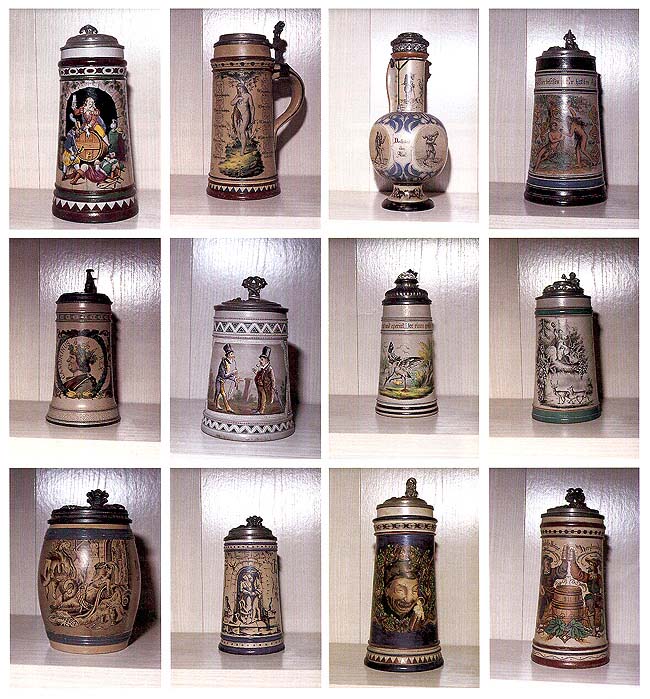The August Saeltzer Factory*
by Ron Fox
History of the Firm
Wilhelm August Saeltzer was born August 25, 1820, the eighth child of Johann Wilhelm Saeltzer, in Eisenach. Wilhelm apprenticed in the potter's trade and spent several years as a journeyman until he passed his Master Exam at age 30.
In 1850 he applied for permission to produce artistic wares. He was the founder of a stove tile factory in 1858, but only supplied local demand.
The Saeltzer factory came into existence at the beginning of the Historismus period in Germany. This was a time of revival and newly found appreciation of the styles of the Renaissance period.
In 1864, August Saeltzer began producing a line of vessels in the Grecian style (Figure 1, a catalog page). They were made of earthenware and elaborately decorated. In 1866 he received medals and awards for his work. The Grecian vessels production continued until 1903. Also in 1866, he added a line of Kreussen-styled steins and medieval jugs. Their inspiration was derived from 17th century pieces from private collections and several museums. The colors and enameling is fine quality and reveals much artistic talent in the workers. Again, this line was made in earthenware, not stoneware (Figure 2, a catalog page).
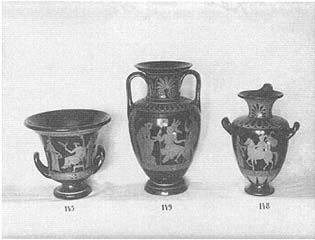 | | Figure 1 |
|
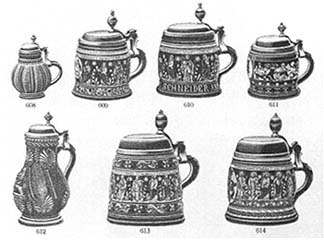 | | Figure 2 |
|
It is important to understand that the Saeltzer factory did not make stoneware. In 1883, they are listed as having 8 workers in the factory and paint shop. Specializing in earthenware and being a small enterprise made it difficult to make earthenware and stoneware simultaneously. So, to limit his business risks, Saeltzer bought his stoneware blanks and decorated them, achieving very good results. Due to this good business decision, his factory did not feel the damage of economic setbacks of the recession, which eliminated other factories of this kind.
August Saeltzer suffered a heart attack on May 10, 1880 and died. He and his wife Julie were childless. The factory kept the firm name of "August Saeltzer, Factory for Antique and Old German Vases and Vessels," but was taken over by Louis Martini.
Louis Martini was born March 26, 1836, and was an embosser and mold maker for Meissen when he left to take over the Saeltzer factory. Martini became famous for his glorification of Wartburg Castle on vessels and was named Supplier to the Court from 1881-1882.
Paul Martini is listed as Director of the company in 1892 and widow Marie Martini as owner in 1898. The factory moved to the city outskirts, but kept a salesroom in the city center. The company is listed as owned by a merchant named Jakob Winkler between 1912-1922. The company ceased after 1930.
My Introduction to Saeltzer
In 1980 I bought a group of steins. In the group was a stoneware stein that I particularly liked. It was hand-painted with detailed scenes. The enameling on the salt glazed gray body gave it an unusual and very pleasing appearance (Figure 3). I had not noticed steins of this type before and was unable to find anyone with information about them.
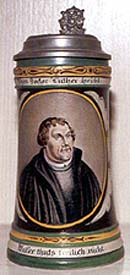 | | Figure 3 |
|
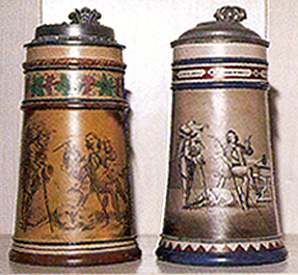 | | Figure 4 |
|
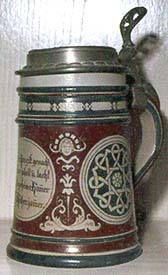 | | Figure 5 |
|
Some years later I attended a local chapter meeting of the Northern California club. A collector brought one of these steins to be evaluated. I recognized the distinctive traits as being from the same factory as the stein I had bought years before, but I could not help him beyond that. The collector would not sell it, but this experience recharged my interest in these steins.
By the time I had about 8 of these steins, I luckily bought one with the base marked "A Saeltzer, Eisenach." This one stein gave me the key I had been looking for.
Unfortunately Eisenach was in East Germany. With the help of a friend living in Germany, I made the trip into the East Block. This was long before the Wall had come down. We nosed around and found a black market antique dealer who was aware of the factory. I was able to buy catalogs from the factory depicting the Grecian urns and Kruessen tankards the company was making in the 1860s. I also obtained an article written by the curator of the Dresden Museum on August Saeltzer. Those catalogs and the article, along with the transcriptions that were provided by Lotte Lopez were invaluable help with the research. I now own well over 100 August Saeltzer steins. It is those steins themselves that have been the greatest teacher.
Traits of the Enameled Stoneware
As mentioned earlier in this article, the Saeltzer factory did not make stoneware. They purchased already-made bodies from several different locations. Their first shipment of blanks came from the Westerwald around 1870. Blanks were also bought from the Fritz Thenn factory in Regensburg. Though they predominately worked on salt glazed stoneware bodies, I have found a Nymphenburg porcelain, as well as a Mettlach blank that they decorated.
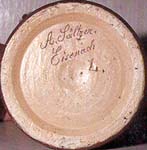 | | Figure 6 |
|
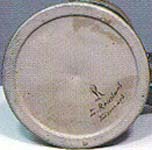 | | Figure 7 |
|
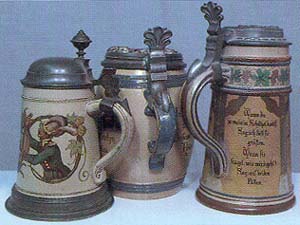 | | Figure 8 |
|
All the decorating was hand-painted. They did not use blank transfer applications or transfer fill-ins. Even though they reused the scenes, the different colors, bodies and hand-painting made them appear to be quite different (Figure 4). The typical colors were very earthen tones. Use of deep maroon, dark blue, green, brown and black were typical in their decorations. The factory can also be identified by their common use of geometric styled belly bands and base rims (Figure 5). Another identifying trait for this factory is that most of their salt glazed stoneware bodies are devoid of capacity marks. This is unusual for German steins.
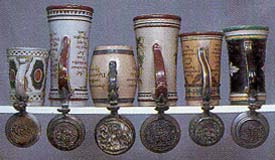 |
| Figure 9 |
Many of their steins are marked with a monogram of an intertwined A.S. There are also markings using capital letters. These are artists' initials (Figure 6). Only the letters LR have been identified as belonging to the artist Louis Rembach (Figure 7). Rembach died in 1908 and in that same year production of painted stoneware in Eisenach ceased.
On the earlier stoneware bodies the handles were hand-formed and hand-applied. Many were set crooked and in a crude manner. At the turn of the century, the handles were cast and are more uniform (Figure 8).
Elaborate pewter lids are also a distinguishing mark of this factory. Although many of the steins were sold lidless, the lidded steins often had brass or copper relief insets or inlays. Their pewtersmiths were artists themselves, embellishing strap supports and thumblift areas with bevels and cutting (Figure 9).
The quality of the painting ranged from primitive to exquisitely detailed. Many of the steins used verses in stylized European calligraphy, surrounded by floral or mosaic geometric designs (Figure 10). Because the factory was founded in the same town as the Wartburg Castle, this was commonly used as subject matter (Figure 11) along with many biblical themes. The Wartburg Castle became the symbol for Evangelical theology due to the fact that Martin Luther sought shelter there. During his stay in the castle, he translated the New Testament from Greek into German. There are steins that depict Martin Luther as well. Munich, being close-by, also lent itself to subject matter for the artists of this factory. Munich maids and Oktoberfest are recurring subjects (Figure 12).
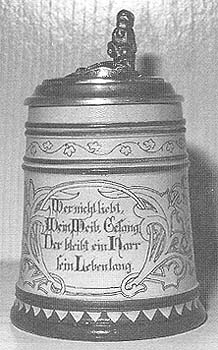 | | Figure 10 |
|
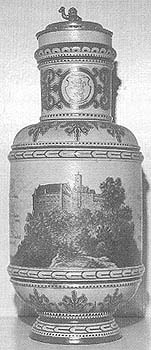 | | Figure 11 |
|
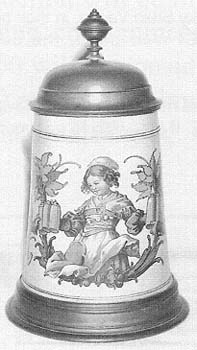 | | Figure 12 |
|
The steins of the factory of August Saeltzer have a distinctive look, once studied. Their appearance is easily recognized and distinguishable in a group of steins. The factory also made pokals, goblets and plaques. There is also one known figural character stein of a monk (Figures 13, 14 & 15).
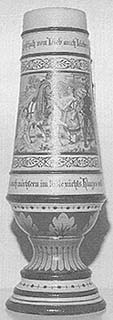 | | Figure 13 |
|
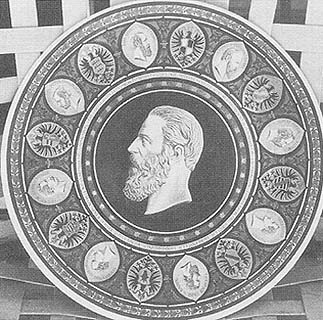 | | Figure 14 |
|
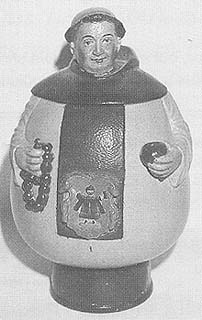 | | Figure 15 |
|
It is often the case that when information is shared in our hobby about a particular category, that category tends to become noticeably sought after. Prices go up and items become scarcer. As a general rule, Saeltzers are hard to find because they were made by a small workshop with a small production. As my research is still continuing, I would appreciate any of you who may run across a Saeltzer piece, to please contact me.
Examples of Saeltzer Steins
__________
*Reprinted by permission from Prosit, the Journal of Stein Collectors International, Vol 2, No. 28, December 1998.




